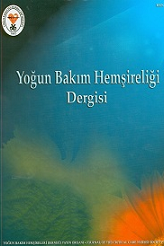YOĞUN BAKIMDA COVİD-19 TANILI ÇOCUK HASTANIN BAKIMI
ÖZET
Ağırlıklı olarak solunum sistemini etkileyen Covid-19 enfeksiyonu, üst solunum yolu semptomlarından, ciddi akut solunum sıkıntısı sendromuna kadar değişen belirtiler göstermektedir. Risk faktörlerini tanımak ve erken tedavi ve bakım sağlamak önemlidir. Yoğun bakımda aerosol üreten prosedürler gerektiren, ciddi vakalarla ilgilenen sağlık çalışanlarına virüsün bulaşması önlenmelidir. Çocuk yoğun bakım hemşiresi, Covid-19 enfeksiyonlu hasta değerlendirmesi, tedavi ve bakımı ile ilgili geliştirilen ulusal ve uluslararası protokolleri takip etmelidir. Bu makalede, COVID-19 bağlı olarak akut solunum sıkıntısı sendromu gelişen, solunum desteği gereken çocuğun hemşirelik bakımını gözden geçirdik.
ABSTRACT
The 2019-coronavirus predominantly affects the respiratory system with manifestations ranging from upper respiratory symptoms to full blown acute respiratory distress syndrome. It is important to recognize the risk factors and provide early treatment and care. Infection of the virus should be prevented to healthcare professionals who are concerned with serious cases requiring aerosol-producing procedures in intensive care. The pediatric intensive care nurse should follow the national and international protocols developed for Covid-19 infected patient assessment, treatment and care. In this article, we reviewed the nursing care of a child who developed acute respiratory distress syndrome due to COVID-19 and needed respiratory support.
___
- 1. Jiatong S, Lanqin, Wenjun L. COVID‐19 epidemic: disease characteristics in children. Journal of medicalvirology 2020.
- 2. Cruz A, Zeichner S. COVID-19 in children: initial characterization of the pediatric disease. Pediatrics. 2020; doi: 10.1542/peds.2020-0834. https://pediatrics.aappublications.org/content/pediatrics/early/2020/03/16/peds.2020-0834.full
- 3. Ravikumar N, Nallasamy K, Bansal A, Angurana SK, Basavaraja GV, Sundaram, M, et al. Intensive care chapter of ındian academy of pediatrics. Novel coronavirus 2019 (2019-ncov) ınfection: part ı-preparedness and management in the pediatric ıntensive care unit in resource-limited settings. Indian Pediatrics, 2020;57: 324-334.
- 4. Peters M. COVID-19: Provisions For Casual Nurses. Anmf Evidence Brief, 2020;26.
- 5. T.C. Sağlık Bakanlığı Halk Sağlığı Genel Müdürlüğü (2020). Covıd-19 (Sarscov2 Enfeksiyonu) Rehberi (Bilim Kurulu Çalışması). 14 Nisan 2020, Ankara
- 6. Panahi L, Amiri M, Pouy S. Clinical characteristics of covıd-19 infection in newborns and pediatrics: a systematic review. Archives of Academic Emergency Medicine, 2020;8(1):50.
- 7. Çocuk Acil Tıp ve Yoğun Bakım Derneği Çocuk Acil Servisi Covıd-19 Olgu Yönetim Algoritmaları, 2020.
- 8. Jackson D, Bradbury-Jones C, Baptiste D, Gelling L, Morin K, Neville S, et.al. Life in the pandemic: some reflections on nursing in the context of COVID-19, Journal of Clinical Nursing, 2020;, doi: 10.1111/jocn.15257
- 9. Sundaram M,Ravikumar N, Bansal A, Nallasamy K, Basavaraja GV, Lodha R.,et al.IntensiveCareChapter of Indian Academy of Pediatrics..NovelCoronavirus 2019 (2019-nCoV) Infection: Part II-RespiratorySupport in thePediatricIntensiveCareUnit in Resource-limitedSettings. IndianPediatrics, 2020;57: 335-342.
- 10. Türk Yoğun Bakım Hemşireleri Derneği, Yoğun Bakım Ünitesinde Görev Alacak Hemşireler İçin Kaynak Kitapçı, Covıd-19 Pandemisi’ne Özel, 2020
- 11. Thampi S, Yap A, Lijia F, Ong J. Special considerations for the management of COVID‐19 pediatric patients in the operating room and pediatric intensive care unit in a tertiary hospital in Singapore. PediatricAnesthesia, 2020;
- ISSN: 1302-0498
- Başlangıç: 1997
- Yayıncı: Yoğun Bakım Hemşireler Derneği
Sayıdaki Diğer Makaleler
COVİD-19 Sürecinde Böbrek Yetmezliği Olan Hastanın Yoğun Bakım Yönetimi
Covid-19 Pandemi Sürecinde Yoğun Bakım Hemşireliği
COVID-19 Pandemisinde Kalp Yetersizliği Hastalarının Yoğun Bakım Yönetimi
COVİD 19 PANDEMİSİ VE HİZMET İÇİ EĞİTİM
Nazik YALNIZ, Ebru KÖSEOĞLU, Arzu KAPLANOĞLU, Sedat ALTİN
COVID-19 Salgınında Yoğun Bakım Ünitelerinin Organizasyonu
COVID-19 SALGINIYLA MÜCADELE: YOĞUN BAKIM HEMŞİRELİĞİ MESLEK ETİĞİ PERSPEKTİFİ
Hülya LEBLEBİCİOĞLU, Fatma NAİR
